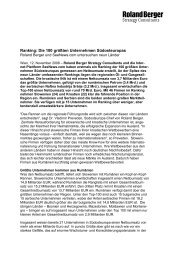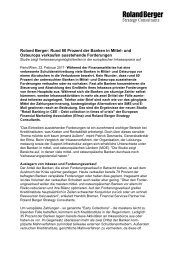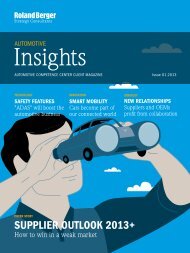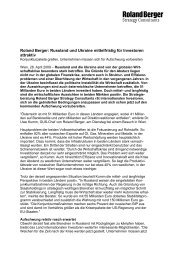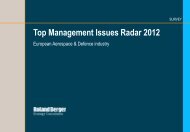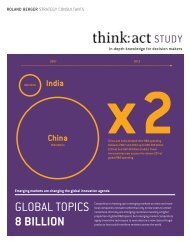China goes West How Chinese companies start to ... - Roland Berger
China goes West How Chinese companies start to ... - Roland Berger
China goes West How Chinese companies start to ... - Roland Berger
You also want an ePaper? Increase the reach of your titles
YUMPU automatically turns print PDFs into web optimized ePapers that Google loves.
<strong>China</strong> <strong>goes</strong> <strong>West</strong><br />
<strong>How</strong> <strong>Chinese</strong> <strong>companies</strong><br />
<strong>start</strong> <strong>to</strong> conquer the<br />
international markets<br />
Key findings<br />
Frankfurt, November 2007<br />
VIE-9801-74000-410-001<br />
1
Content<br />
Page<br />
Macroeconomic data 3<br />
Challenges and opportunities for expanding <strong>Chinese</strong> <strong>companies</strong> 8<br />
Conclusion 12<br />
<strong>Roland</strong> <strong>Berger</strong>'s "The Most Globally Competitive <strong>Chinese</strong> Companies" award 13<br />
Key facts about <strong>Roland</strong> <strong>Berger</strong> Strategy Consultants 16<br />
VIE-9801-74000-410-001<br />
2
Imports of developed economies from <strong>China</strong> are growing<br />
strongly – Multinationals source from own production capacities<br />
Import volume 1) from <strong>China</strong> [USD bn] and number of foreign affiliates in <strong>China</strong><br />
Importers<br />
# of foreign affiliates 1,2)<br />
Comments<br />
US<br />
GERMANY<br />
UK<br />
As % of<br />
US imports<br />
As % of<br />
GER imports<br />
As % of<br />
UK imports<br />
2.8% 3.5% 8.1%<br />
27<br />
52<br />
163<br />
1996 2000 2005<br />
1.0% 1.5% 3.3%<br />
6<br />
9<br />
33<br />
1996 2000 2005<br />
0.9% 1.5% 2.8%<br />
3<br />
6<br />
19<br />
1996 2000 2005<br />
CAGR<br />
22%<br />
CAGR<br />
21%<br />
CAGR<br />
22%<br />
CAGR 19%<br />
280,000<br />
49,604<br />
1994 2004<br />
> Imports of key developed<br />
markets from <strong>China</strong> have<br />
been growing at a yearly<br />
rate of ~20% since 1996<br />
> Substantial share of<br />
such imports is generated<br />
by subsidiaries of multinational<br />
<strong>companies</strong><br />
through local production<br />
capacities<br />
> The number of foreign<br />
affiliates in <strong>China</strong> has<br />
increased almost sixfold<br />
between 1994 and 2004<br />
1) Including Hong Kong 2) Including Joint Ventures<br />
Source: UNCTAD World Investment Report 2006; <strong>Roland</strong> <strong>Berger</strong> analysis<br />
VIE-9801-74000-410-001<br />
3
As a result, mainland <strong>China</strong> has replaced France <strong>to</strong> become<br />
world's third largest recipient of FDI<br />
FDI inflow per country [USD bn; 2005]<br />
Top target countries<br />
Global distribution<br />
165<br />
18%<br />
UK<br />
99<br />
72<br />
64<br />
Other 56%<br />
11% US<br />
8%<br />
7% <strong>China</strong><br />
France<br />
UK<br />
US<br />
<strong>China</strong><br />
France<br />
2005 <strong>to</strong>tal global FDI = USD 916 bn<br />
> Global inflow of FDI remains highly concentrated, mainly targeting <strong>to</strong>p developed countries<br />
> <strong>China</strong> has, however, now become the third largest recipient of global FDI, achieving a stable 8%<br />
share in recent years<br />
Source: UNCTAD World Investment Report 2006; <strong>Roland</strong> <strong>Berger</strong> analysis<br />
VIE-9801-74000-410-001<br />
4
In terms of FDI outflow, <strong>companies</strong> in Europe and the United States<br />
continue <strong>to</strong> dominate – Share of mainland <strong>China</strong> not yet significant<br />
FDI outflow per country [USD bn]<br />
Global FDI<br />
outflow<br />
volume<br />
398<br />
CAGR 9.3%<br />
813<br />
Comments<br />
> European and North American<br />
countries are the primary sources of<br />
capital for FDI, initiating 80% of <strong>to</strong>tal<br />
foreign direct investments in 2004<br />
Regional<br />
distribution<br />
South America<br />
Mainl. <strong>China</strong><br />
Other<br />
Asia w/o<br />
<strong>China</strong><br />
1%<br />
20% 2%<br />
1%<br />
North<br />
America<br />
25%<br />
1996 2004<br />
52%<br />
Europe<br />
Mainl. <strong>China</strong><br />
Asia w/o<br />
<strong>China</strong><br />
North<br />
America<br />
0%<br />
16% 3%<br />
1%<br />
33%<br />
South America<br />
Other<br />
47%<br />
Europe<br />
> Large fluctuations on a year-<strong>to</strong>-year<br />
basis are attributable <strong>to</strong> the volatility of<br />
M&A deal volume<br />
> Asia as a whole has lost some ground<br />
<strong>to</strong> developed countries; yet regional<br />
differences remain<br />
> Mainland <strong>China</strong> did not yet increase<br />
its overall share until 2004, but 2005<br />
share reached an overall high of 1.5%<br />
> Hong Kong, on the other hand, is the<br />
single largest source of FDI among<br />
developing nations<br />
Source: UNCTAD World Investment Report 2006 and 1997; <strong>Roland</strong> <strong>Berger</strong> analysis<br />
VIE-9801-74000-410-001<br />
5
Outward M&A activities by mainland <strong>Chinese</strong> <strong>companies</strong> have<br />
accelerated over the last years …<br />
Number & volume of overseas M&A deals of <strong>Chinese</strong> <strong>companies</strong> [1996-2005]<br />
# of M&A<br />
deals<br />
CAGR 13%<br />
73<br />
59<br />
58<br />
17<br />
30<br />
23<br />
13<br />
35<br />
22<br />
35<br />
1996<br />
1997<br />
1998<br />
1999<br />
2000<br />
2001<br />
2002<br />
2003<br />
2004<br />
2005<br />
Volume of<br />
M&A deals<br />
[USD bn]<br />
CAGR 31%<br />
5.3<br />
0.4<br />
0.8<br />
1.3<br />
0.1<br />
0.5<br />
0.5<br />
1.0<br />
1.6<br />
1.1<br />
1996<br />
1997<br />
1998<br />
1999<br />
2000<br />
2001<br />
2002<br />
2003<br />
2004<br />
2005<br />
Source: UNCTAD World Investment Report 2006; <strong>Roland</strong> <strong>Berger</strong> analysis<br />
VIE-9801-74000-410-001<br />
6
… but are still on a very low level compared <strong>to</strong> the EU<br />
M&A purchases (country of origin) 1996-2005 [USD bn]<br />
<strong>China</strong><br />
European Union<br />
Comments<br />
CAGR +17%<br />
387<br />
> <strong>Chinese</strong> <strong>companies</strong> are still in a<br />
very early stage in outward M&A<br />
> Outward M&A purchases have<br />
increased at a faster rate in <strong>China</strong><br />
than in the European Union (25<br />
members)<br />
CAGR +31%<br />
0 5<br />
0.2%<br />
of<br />
GDP<br />
97<br />
2.8%<br />
of<br />
GDP<br />
> Nevertheless, <strong>Chinese</strong> outward<br />
purchases through M&A only<br />
account <strong>to</strong> 0.2% of nominal GDP,<br />
compared <strong>to</strong> 2.8% in the European<br />
Union<br />
1996 2005<br />
1996 2005<br />
Source: UNCTAD World Investment Report 2006; <strong>Roland</strong> <strong>Berger</strong> analysis<br />
VIE-9801-74000-410-001<br />
7
With the exception of a competitive cost basis, <strong>Chinese</strong> <strong>companies</strong><br />
are still facing numerous challenges in their global expansion<br />
> Limited R&D capabilities – Difficulties breaking in<strong>to</strong> high-end market segments<br />
– R&D capabilities in <strong>China</strong> are still generally low, which hinders <strong>Chinese</strong> <strong>companies</strong> in entering more<br />
profitable high-end market segments<br />
> Weak brands with limited international marketing experience and few distribution channels<br />
– The strong focus on manufacturing has diverted attention from brand development<br />
– Only Haier belongs <strong>to</strong> the <strong>to</strong>p 100 of the most famous brands in the world<br />
> Insufficient knowledge of foreign markets<br />
– the insufficient knowledge of foreign markets (competition/ products/ local differences/ design/ rules<br />
and regulations…)<br />
> Still low managerial capacity in the global environment<br />
– the still low managerial capacities of <strong>Chinese</strong> executives when faced with different social rules and<br />
business environments<br />
> Stil bad reputation of the “Made in <strong>China</strong>” in respect <strong>to</strong> quality<br />
– the (still) bad reputation of the "Made in <strong>China</strong>" very often associated with poor quality and low<br />
standards (according <strong>to</strong> a 2007 NBC Wall street survey, 82% of the Americans do not trust <strong>Chinese</strong><br />
products quality)<br />
Source: <strong>Roland</strong> <strong>Berger</strong> analysis<br />
VIE-9801-74000-410-001<br />
8
Five key success fac<strong>to</strong>rs have been identified for <strong>Chinese</strong><br />
<strong>companies</strong> <strong>to</strong> compete successfully overseas<br />
1<br />
2<br />
3<br />
4<br />
5<br />
Continuously improving manufacturing productivity and quality<br />
> As wages - both in absolute terms and relative <strong>to</strong> other low-wage regions - increase, the role of technology,<br />
techniques and processes in productivity improvement is becoming even more significant<br />
Increased and systematic investment in R&D<br />
> A strong R&D capability has become one of the leading competitive fac<strong>to</strong>rs in many of the industries, in which<br />
<strong>China</strong> is trying <strong>to</strong> compete. <strong>China</strong> not only needs <strong>to</strong> develop its know-how in product technology, but in production<br />
processes as well<br />
Strong brand recognition<br />
> In order for <strong>China</strong>'s industrial economy <strong>to</strong> advance <strong>to</strong> the next stage of development, its <strong>companies</strong> have <strong>to</strong> own<br />
brands that are recognizable and well thought of outside of <strong>China</strong>. At present, there are less than a handful of<br />
<strong>Chinese</strong> brands that meet these criteria<br />
Excellent HR skills and access <strong>to</strong> talent<br />
> The shortage of skilled and trained human resources for international business is one of <strong>China</strong>'s greatest<br />
constraints. This is particularly true in management areas such as senior leadership, marketing, operations, and<br />
R&D. What is missing is not only experience, but also training programs, strategic planning capabilities and global<br />
perspectives<br />
Usage of external consultants<br />
> Many of the challenging tasks identified above can be addressed effectively with the use of appropriate consultants<br />
with world-class credentials in industrial and market analysis, strategic planning, organization management, and<br />
legal and M&A transactions<br />
Source: <strong>Roland</strong> <strong>Berger</strong> analysis<br />
VIE-9801-74000-410-001<br />
9
Growth patterns of the expansion of <strong>Chinese</strong> <strong>companies</strong> can be<br />
divided in<strong>to</strong> three groups – Organic growth, alliances and M&A<br />
Summary of growth patterns of the expansion of <strong>Chinese</strong> <strong>companies</strong><br />
Description Possible approaches Company examples<br />
Organic<br />
growth<br />
> Business expansion through<br />
increasing output and sales as<br />
opposed <strong>to</strong> mergers,<br />
acquisitions and takeovers<br />
> Direct export<br />
> Greenfield investments<br />
> Haier Group<br />
> Huawei Technologies<br />
Alliances/<br />
partnerships<br />
> Business expansion through<br />
alliances or confederating<br />
> Cooperation with OEMs<br />
> <strong>Chinese</strong> <strong>companies</strong> set up joint<br />
venture <strong>to</strong> invest abroad<br />
> Chery signed cooperative<br />
agreement <strong>to</strong> build small cars<br />
under Chrysler brand for sale in<br />
the US and elsewhere<br />
Mergers<br />
and<br />
acquisitions<br />
> Business expansion through<br />
buying, selling and combining<br />
of different <strong>companies</strong><br />
> Acquire overseas natural<br />
resources<br />
> Acquire overseas brand<br />
> Acquire overseas <strong>companies</strong><br />
for know-how<br />
> CNOOC<br />
> Minmetal<br />
> Lenovo’s acquisition of IBM PC<br />
> Shanghai Au<strong>to</strong>motive Industry<br />
Corporation’s acquisition of<br />
Rover technology<br />
Source: <strong>Roland</strong> <strong>Berger</strong> analysis<br />
VIE-9801-74000-410-001<br />
10
Success s<strong>to</strong>ries: Intensive globalization is the basis for growth<br />
Organic<br />
growth<br />
To expand in<strong>to</strong> overseas markets through organic growth<br />
> Haier <strong>start</strong>ed in the US by targeting niche markets, than<br />
progressively accumulated market share and strengthened its<br />
internal capabilities in overseas operations<br />
> Huawei invests 10% of its revenue in R&D each year<br />
Growth by<br />
alliance<br />
To expand in<strong>to</strong> overseas markets through alliances<br />
> Not only did Chery focus on R&D <strong>to</strong> provide best-in-class<br />
products, it also acquired overseas know-how through the<br />
strategic alliance agreement with Chrysler, thereby gaining<br />
access <strong>to</strong> sales channels in North America<br />
Growth by<br />
M&A<br />
To acquire superior brands and technologies<br />
> Besides focusing on R&D <strong>to</strong> strengthen their products, Lenovo<br />
acquired western management talent through its acquisition of<br />
IBM’s PC division<br />
Source: <strong>Roland</strong> <strong>Berger</strong> analysis<br />
VIE-9801-74000-410-001<br />
11
Bot<strong>to</strong>m line: <strong>China</strong>'s outward integration in<strong>to</strong> the world<br />
economy is going <strong>to</strong> continue and accelerate<br />
Conclusion<br />
> <strong>China</strong>'s ascent as a global economic power is giving rise <strong>to</strong> a growing group<br />
of <strong>Chinese</strong> <strong>companies</strong> with the potential <strong>to</strong> become global players over<br />
the next decade<br />
> Though overall <strong>Chinese</strong> <strong>companies</strong>' global performance has potential room for<br />
improvement, the trend is clear: <strong>China</strong>'s outward integration in<strong>to</strong> the world<br />
economy is going <strong>to</strong> continue and accelerate, providing mutual economic<br />
benefits <strong>to</strong> both <strong>Chinese</strong> and foreign enterprises<br />
> <strong>How</strong>ever, success will not come easily; and only <strong>companies</strong> with clear,<br />
focused strategies, strong execution capabilities and substantial international<br />
business know-how can reap the potential rewards<br />
Source: <strong>Roland</strong> <strong>Berger</strong> analysis<br />
VIE-9801-74000-410-001<br />
12
<strong>China</strong>'s strongest international firms were honored with the<br />
"The Most Globally Competitive <strong>Chinese</strong> Companies" award<br />
Selected company profiles from <strong>to</strong>p 20 winning <strong>companies</strong> (state owned enterprises) 1)<br />
Company<br />
Industry<br />
Revenue<br />
(2006)<br />
[EUR m]<br />
Growth<br />
(CAGR<br />
2003-2006)<br />
Overseas revenue<br />
as % of <strong>to</strong>tal<br />
revenue (2006)<br />
Recent overseas activities<br />
<strong>China</strong> National<br />
Offshore Oil<br />
Corporation<br />
(CNOOC)<br />
Oil/gas<br />
11,766<br />
43.8%<br />
16.0%<br />
> April 2006 – Raised 15 billion Hong Kong<br />
dollar overseas investment<br />
> April 2006 – Signed exploration contract with<br />
Kenya government<br />
> 2006 – Announced enhancing investment in<br />
overseas exploration activities<br />
<strong>China</strong> International<br />
Marine<br />
Containers<br />
(Group) Co., Ltd.<br />
Engineered<br />
Products<br />
3,231<br />
38.7%<br />
93.0%<br />
> June 2007 – Announced successful acquisition<br />
of Netherland‘s Burg Industries BV<br />
> December 2006 – Founded a joint-venture<br />
with Burg Industries BV<br />
Shanghai<br />
Au<strong>to</strong>motive<br />
Industry<br />
Corporation<br />
(SAIC)<br />
Au<strong>to</strong>mobile<br />
11,053 -15.2% 6.0%<br />
> Oc<strong>to</strong>ber 2006 – Launched its first fully<br />
patented and branded car Roewe, on the<br />
basis of purchased Rover technology in 2004<br />
and planned <strong>to</strong> export through the sales<br />
channel of Ssang Yong, acquired by SAIC<br />
also in 2004<br />
1) The <strong>companies</strong> listed are selected as best representatives of winning enterprises in each category (state owned- and private enterprises and emerging high-tech firms)<br />
Source: Company annual reports; <strong>Roland</strong> <strong>Berger</strong> analysis<br />
VIE-9801-74000-410-001<br />
13
<strong>Roland</strong> <strong>Berger</strong> analyzed over 200 <strong>companies</strong> and revealed<br />
those 20 with exemplary internationalization strategies<br />
Selected company profiles from <strong>to</strong>p 20 winning <strong>companies</strong> (private <strong>companies</strong>)<br />
Company<br />
Industry<br />
Revenue<br />
(2006)<br />
[EUR m]<br />
Growth<br />
(CAGR<br />
2003-2006)<br />
Overseas revenue<br />
as % of <strong>to</strong>tal<br />
revenue (2006)<br />
Recent overseas activities<br />
Huawei<br />
Technologies<br />
Haier Group<br />
Lenovo Group<br />
Telecom<br />
equipment<br />
Consumer<br />
durables<br />
PCs<br />
6,390<br />
10,520<br />
10,130<br />
27.2%<br />
6.3%<br />
100.0%<br />
65.0%<br />
24.7%<br />
65.0%<br />
> June 2007 – Continued <strong>to</strong> make inroads in<br />
the European market via signing contract<br />
with Vodafone Spain<br />
> December 2006 – Signed contract with<br />
Telecom Italia SpA – the first <strong>Chinese</strong> vendor<br />
<strong>to</strong> be awarded a contract in Italy<br />
> December 2005 – Named one of the leading<br />
vendors in the British Telecom (BT) 21 CN<br />
network<br />
> 2007 - Plans <strong>to</strong> increase the number of<br />
overseas manufacturing bases from 13 now<br />
<strong>to</strong> 20 by 2010<br />
> Oc<strong>to</strong>ber 2006 – Reached an agreement with<br />
Japanese company Sanyo <strong>to</strong> establish a joint<br />
venture<br />
> July 2007 – Announced it would build two<br />
new plants in Mexico and India<br />
> Oc<strong>to</strong>ber 2006 – Signed a multi-year global<br />
marketing partnership with NBA<br />
Source: Company annual reports; <strong>Roland</strong> <strong>Berger</strong> analysis<br />
VIE-9801-74000-410-001<br />
14
The <strong>to</strong>p international performers included emerging high-tech<br />
firms Sun Tech Solar and Chery Au<strong>to</strong>mobile<br />
Selected company profiles from <strong>to</strong>p 20 winning <strong>companies</strong> (emerging high-tech firms)<br />
Company<br />
Industry<br />
Revenue<br />
(2006)<br />
[EUR m]<br />
Growth<br />
(CAGR<br />
2003-2006)<br />
Overseas revenue<br />
as % of <strong>to</strong>tal<br />
revenue (2006)<br />
Recent overseas activities<br />
Sun Tech Solar<br />
Co., Ltd.<br />
Energy<br />
438<br />
88.7%<br />
82.0%<br />
> August 2006 – Acquired Japanese competi<strong>to</strong>r<br />
MSK<br />
> 2006 – Signed a 10-year contract <strong>to</strong> secure<br />
silicon supply<br />
Chery<br />
Au<strong>to</strong>mobile Co.,<br />
Ltd.<br />
Au<strong>to</strong>mobile<br />
1,929<br />
43.8%<br />
3.5%<br />
> July 2007 – Signed contract with Chrysler <strong>to</strong><br />
produce Chery in <strong>China</strong> and market in North<br />
America and EU<br />
> June 2007 – Established joint-venture with<br />
Quantum<br />
> 2006 – Founded its first overseas company in<br />
Russia<br />
Source: Company annual reports; <strong>Roland</strong> <strong>Berger</strong> analysis<br />
VIE-9801-74000-410-001<br />
15
<strong>Roland</strong> <strong>Berger</strong> Strategy Consultants combine global<br />
competence with local know-how<br />
Key facts about <strong>Roland</strong> <strong>Berger</strong> Strategy Consultants<br />
33 offices in 23 countries all over the world<br />
1,700 employees worldwide<br />
Specific strengths in Europe (25 offices), The Americas (3 offices), and Asia (5 offices)<br />
Revenues of EUR 555 m in 2006<br />
Average growth p.a. 17%<br />
75% of all projects with international focus<br />
VIE-9801-74000-410-001<br />
16
Would you like <strong>to</strong> know more?<br />
Vincent Mercier<br />
Member of <strong>Roland</strong> <strong>Berger</strong><br />
Strategy Consultants'<br />
Executive Committee<br />
Phone: +33 (1) 53670-326<br />
e-mail: Vincent_Mercier@fr.rolandberger.com<br />
Jochen Gleisberg<br />
Partner and Head of<br />
<strong>Roland</strong> <strong>Berger</strong> Strategy<br />
Consultants' <strong>China</strong> Desk<br />
Phone: +49 (711) 3275 7221<br />
e-mail: Jochen_Gleisberg@de.rolandberger.com<br />
VIE-9801-74000-410-001<br />
17



